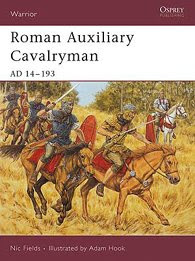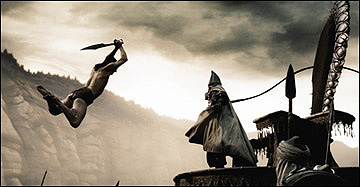In a previous post, I drew attention to the bizarre theory that the King Arthur of legend was actually a 2nd century Roman officer named Lucius Artorius Castus.
An anonymous visitor to that post recently asked, "Is it true that there are common elements, not only between the names but details of Artorius's life and Arthur's?" The short answer is: No, it's not true. But I know you'd prefer the long answer.
The folklorist and doyenne of Arthurian mythology, Linda Malcor, has published an article in The Heroic Age (a web-based "Journal of Early Medieval Northwestern Europe") entitled Lucius Artorius Castus: The Battles in Britain. Here, she alleges that "certain details of Castus's military career in Britain correspond to details in the traditional biography of the legendary King Arthur". It is worth taking a closer look at those alleged parallels.
Artorius and the Sarmatians?

Dr Malcor writes that "Arthur's men were armored cavalry who fought with swords, lances and shields; while in Britain, Castus commanded Sarmatian numerii [sic] from fort Bremetennacum". She claims that this proves that they were one and the same man. But I have already demolished the Sarmatian link. The facts are these: in AD 175, the emperor Marcus Aurelius (of Gladiator fame) transported 5,500 Sarmatian horsemen to Britain. For 65 years, they disappeared from history, and were perhaps dispersed across the province to reinforce other garrisons; but around AD 240 a numerus equitum Sarmatarum (or "unit of Sarmatian horse") made their presence known at the fort of Ribchester, ancient Bremetennacum (pictured). It was the opinion of the eminent archaeologist Professor Sir Ian Richmond that Sarmatian tribesmen had settled in the area, but definite proof is lacking.
Of course, Dr Malcor is quite wrong to claim that "Castus commanded Sarmatian numerii". In fact, Artorius Castus held a succession of legionary centurionates, culminating in the post of praefectus legionis VI Victricis ("prefect of the Victorious Sixth Legion"), after which he commanded a battle group in northern France drawn from the legions and cavalry regiments of Britain. At no stage was he a cavalry prefect (which would have required an entirely different career path).
Artorius in Northern England?

Dr Malcor's main argument states that "the second-century dux Lucius Artorius Castus most likely fought a series of battles that does happen to fit the battle list [of King Arthur]". But again, she is quite wrong. (This battle list appears in an early medieval manuscript [pictured] of the Historia Brittonum or "History of the Britons" usually attributed to Nennius; it constitutes a series of 12 vague locations for Arthurian battles, apparently translated from Old Welsh into Latin.) Remember: all we know about Artorius Castus' time in Britain is that he was attached to the VIth Legion at York, probably for a year, and led a battle group across the Channel adversus Armoricanos, "against the Armoricans".
However, Dr Malcor embarks on the narrative of a "Caledonian invasion", which should be classified as historical fiction: "In 183 the Caledonii breached the Antonine Wall and flooded south", she writes; "the Roman forts -Trimontium, Habitancum, Cappuck, and Bremenium - collapsed along the road that became known as Dere Street", and the invaders "attacked Eboracum (York), where they killed a Roman general".
The facts, ma'am.
Let's consider the facts: the Roman historian Cassius Dio records that, during the reign of Commodus, "the tribes in the island crossed the wall that separated them from the Roman forts, doing much damage and killing a general and the troops he had with him; Commodus in alarm sent Ulpius Marcellus against them". Not Artorius Castus, but Ulpius Marcellus, the senatorial governor who is known to have been in the province by 23 March AD 178. The Romans had evacuated the Antonine Wall almost twenty years earlier, along with the Scottish forts listed by Dr Malcor, so the wall that the barbarians crossed must be Hadrian's Wall. But the tribes are not identified (so we don't know if they were "Caledonian"), and there is no reason to suppose that the Roman general was killed in York.
However, Dr Malcor is not constrained by the evidence. "By the time Marcellus arrived," she continues, "the fighting was no longer south of Hadrian's Wall but in southern Scotland, north of the Forth-Clyde Isthmus, and he ordered the successful commander to pursue a punitive campaign against the invaders, that is, if possible, to exterminate them all." This is pure fantasy. Firstly, it seems that Marcellus was already in the province; he probably moved swiftly to the northern frontier from the provincial capital at London, gathering troops as he went. Secondly, the resulting warfare may well have taken place in southern Scotland (which is south of the Forth-Clyde isthmus!), but Cassius Dio doesn't tell us. And thirdly, the "successful commander" was Marcellus himself.
The fantasy.
In her summing up, Dr Malcor's theory can be seen to have no basis in fact. "In 185 Lucius Artorius Castus was promoted to the rank of dux," -- actually, we don't know when he was promoted as the inscription remains undated -- "a position that very few equestrians held prior to the time of Diocletian" -- actually, during the Principate (the period prior to Diocletian), dux was a temporary command or function, not a rank, and was invented to give non-senators the temporary authority of a senatorial legate -- "... the pattern of destruction from 183 to 185, attested by archaeological finds suggests that Castus was the victorious commander who reversed the disaster for the Romans," -- no, we've already seen that it was Ulpius Marcellus who was sent to deal with the problem -- "and the troops he used were the Sarmatian cavalry of Bremetennacum". Hold on, there! Where did that last bit suddenly come from? Nobody, but nobody, has mentioned anything about Sarmatian cavalry! (See Artorius and the Sarmatians?, above.)
It seems that Dr Malcor has erected a teetering edifice of half-truths: "Castus's campaign, like Arthur's, consolidated Britain following a period of infighting (in Castus's case, this involved the mutinee of the VI Victrix)" -- mutiny?! -- "the victorious campaign conducted by Castus with the Sarmatians of Bremetennacum (Ribchester) preserved Britain for the Romans" -- again with the Sarmatians! -- "and certainly sky-rocketed Castus's career into realms rarely seen by an equestrian of his day."
Remember one thing: the career of Lucius Artorius Castus remains undated, so he may not even have been in Britain in AD 180. And if he had any connection whatsoever with Sarmatians, he certainly didn't tell anyone about it!
 The find is a tombstone belonging to Crescens, a Roman cavalryman, and would originally have sported an ostentatious depiction of the man in action. This part probably broke off when the stone fell over, and perhaps awaits discovery in the earth nearby. The part that remains is the short curriculum vitae appended by Crescens' heir, who erected the stone in his memory.
The find is a tombstone belonging to Crescens, a Roman cavalryman, and would originally have sported an ostentatious depiction of the man in action. This part probably broke off when the stone fell over, and perhaps awaits discovery in the earth nearby. The part that remains is the short curriculum vitae appended by Crescens' heir, who erected the stone in his memory.
 Historic Scotland's
Historic Scotland's 








